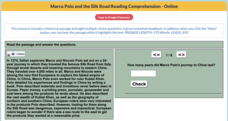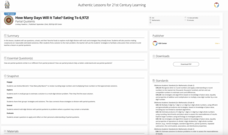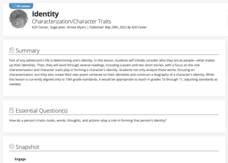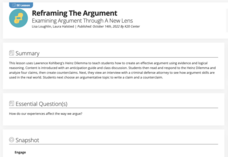Arcademics
Octopus Feed
A fast-paced multiplayer game challenges scholars to identify homophones. Once the timer starts, a player's octopus grabs the focus word's homophone pair with its tentacle. The faster and more accurate a participant is, the more...
American Museum of Natural History
Feed the Birds
Scholars use a large carton, string, an emery board, and bird food to create a hand-made bird feeder. After completing the craft, pupils keep a journal to track their observations.
American Museum of Natural History
Create a Coral Reef
Scholars create a diorama to showcase a vibrant coral reef. Six steps walk pupils through setting up the diorama box, crafting four different types of marine life, and putting it all together.
American Museum of Natural History
Make a Home for Microbes
Make a Winogradsky Column to discover how microbes live within the digestive tract. First, participants take a tour of the stomach. Then, gather supplies and start building using a variety of materials. Over eight to 10 weeks,...
American Museum of Natural History
Cosmic Cookies
Scholars read about each planet then bake a plate of cosmic cookies—no-bake cookies decorated to look like the planets; Mercury, Venus, Earth, Mars, Jupiter, Saturn, Uranus, Neptune, and Pluto.
California Department of Education
What’s the Market for My Labor?
A lesson showcases how knowing about Labor Market Information (LMI) supports searching for future job opportunities. Following a review of the concept and other vocabulary terms, scholars research occupations and answer questions on...
California Department of Education
Who Am I?
Inspire scholars to strive for a career in a field they love. Using a game that looks at likes and dislikes, learners discover their Holland code using a three-interest area survey. With their targeted interests confirmed, pupils...
California Department of Education
Roadmap to Success
It's never too early to start thinking of one's future. Over two class sessions, scholars create a roadmap to meet short and long-term goals related to high school graduation. Roadmaps include the timeline, checkpoints, and...
Livaudais-Baker English Classroom
Literacy Analysis for Lord of the Flies
Here's an assignment sheet that models for readers how to craft a literary analysis of William Golding's Lord of the Flies. The packet includes a graphic organizer, a model outline, a model essay, and a detailed rubric.
Livaudais-Baker English Classroom
Literature Circles
Keeping readers focused during literature discussion circles can sometimes be a challenge. Check out this worksheet that ensures accountability by establishing six very specific, very different roles for group members: facilitator,...
Mr. Nussbaum
Christopher Columbus
Scholars use their reading comprehension skills to answer questions about a short informative text regarding Christopher Columbus. A progress report follows eight questions—multiple-choice and fill-in-the-blank.
News Literacy Project
News Goggles: Tracking Developing Stories
A 28-slide presentation introduces viewers to the process reports go through to track and verify developing news stories. Using the reports of the attacks at Atlanta, Georgia, massage parlors as an example, viewers are taught what to...
Mr. Nussbaum
Silk Road
Challenge pupils to read informational text about the Silk Road. Scholars then take their newfound knowledge to answer a mix of eight fill-in-the-blank and multiple-choice questions. Report details appear at the end.
Mr. Nussbaum
Boston Tea Party
Scholars test their reading comprehension skills with an interactive practice. After reading about the Boston Tea Party, learners answer 10 multiple-choice questions. A progress report details their work.
K20 LEARN
How Many Days Will It Take? Eating To 6,972!: Partial Quotients
The story, How Many Jelly Beans? by Andrea Menotti introduces a lesson about partial quotients. Mathematicians practice rounding and multiplying, then work in small groups to connect those skills with division and partial...
John F. Kennedy Center
Comparing Cultural Holidays
A lesson examines the holidays, Día de los Muertos and Halloween. After an exciting clip from the movie Coco, class members review vocabulary and discuss what they know about Halloween. The conversation leads into the history of Día...
K20 LEARN
The Monkey's Paw - Be Careful What You Wish For: Foreshadowing
W. W. Jacobs' horror story, "The Monkey's Paw," is used to introduce foreshadowing. As they advance through the story, young readers make predictions about what might happen next and how the story might end. Pairs work through the...
K20 LEARN
The K20 Chronicle, Lesson 1: What Makes a Good Article?
Good news articles are engaging, informative, and often compelling. In the first lesson plan of the four-part series, young journalists analyze and evaluate news stories about former NBA player Enes Kanter Freedom. They learn about...
K20 LEARN
The K20 Chronicle, Lesson 3: Crafting the Article
Picture your class members as photojournalists! Using their interview with a senior as a starting point, would-be photojournalists begin developing an outline for their article by examining their notes from the interview, gathering...
K20 LEARN
Allotment in Indian Territory: Land Openings in Indian Territory
To understand how the allotment policy embedded in the Dawes Act, passed by the U.S. government in 1887, affected the tribal sovereignty of Native Americans, young historians examine various maps and documents and Supreme Court...
K20 LEARN
No Imitations, Please! Avoiding Plagiarism
With all the stuff available online, good essays are just a click away. But talk about tracking! Writers beware! New tech can now identify plagiarism, and the consequences of presenting someone else's work as your own are severe. Here's...
K20 LEARN
If You Give a Mouse a Cookie: Conditional Statements
If, then, Else is not only a basic programming language command, it is also the basis for conditional statements used in writing. Middle schoolers try to craft conditional statements with a card sort activity and then collaborate on a...
K20 LEARN
Identity: Characterization/Character Traits
"Who am I?" Guy de Maupassant's short story "The Necklace," Julio Naboa Polanco's poem "Identity," and a clip from a Jason Bourne film provide learners with a context to consider the traits that makeup identity. Scholars create a...
K20 LEARN
Reframing the Argument: Examining Argument through a New Lens
As part of a study of crafting compelling arguments, class members tackle the problem presented in Lawrence Kohlberg's "The Heinz Dilemma." After discussing the dilemma with classmates, writers draft an essay with a claim, support...
Other popular searches
- Learning Styles
- Leadership Styles
- Conflict Resolution Styles
- Architectural Styles
- Classical Music Styles
- Art Styles
- Personal Management Styles
- Communication Styles
- Architecture Styles
- Musical Styles
- Learning Styles Inventory
- Film Styles























